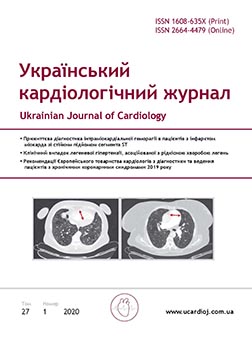Edaravone in contrast-induced acute kidney injury prophelaxis
Main Article Content
Abstract
The aim – to evaluate the effectiveness of edaravon in preventing the development of contrast-induced acute kidney injury.
Materials and methods. We have conducted a multicenter open prospective randomized controlled study to evaluate the efficacy of edaravone in preventing contrast-induced acute kidney injury in patients with chronic kidney disease (CKD) 3b–4 stages. The study included 2 groups of patients aged 46 to 68 (55±3): group A (n=16) with CKD stage 3b or 4 (еstimated glomerular filtration rate (formula СКD-EPI) 32±4 ml/min) that received intravenous edaravone 30 mg bid on 0, 1, 2 day of contrast media infusion and control group B (n=20) with CKD stage 3b or 4 (еstimated glomerular filtration rate 33±3 ml/min) with no edaravone intervention during CT coronarography. Patients of both groups received intravenous hydration with 0.9 % sodium before CT. Primary endpoint: contrast-induced acute kidney injury onset in 48 hours after contrast media infusion and need for RRT. Secondary endpoint: serum potassium level above 5.5 mmol/l.
Results. Contrast-induced acute kidney injury onset was obtained in 4 patients of group A and 12 patients of group B (p≤0.05, RR 0.417, RRR 0.583, RD 0.350, NNT 2.857). The results shows statistical significance both of endpoints which demonstrates the promising possibilities for contrast-induced acute kidney injury prophylaxis with edaravone in CKD 3b–4. Individual data analyses shows that edaravone was more effective in CKD 3b (3 cases of contrast-induced acute kidney injury of 10) instead of CKD 4 (1 of 2).
Conclusions. Edaravone is promising solution for contrast-induced acute kidney injury prevention in patients with CKD 3b–4 who urgently undergo CT coronarography.
Article Details
Keywords:
References
Cheungpasitporn W., Thongprayoon C., Srivali N. et al. Preoperetive RAS inhibitors use linked to reduced AKI: a systematic review and meta-analysis // NDT.– 2015.– 30.–Р. 978–988.
Ene-Iordache B., Perico N., Bikbov B. et al. CKD and cardiovascular risk in six regions of the world (ISN-KDDC) // Lancet Glob Health.– 2016.– Vol. 4 (5).– P. e307–319.
Eng J., Wilson R.F., Subramaniam R.M. et al. Comparative effect of contrast media type on the incidence of contrast-induced nephropathy: a systematic review and meta-analysis // Ann. Intern. Med.– 2016.– Vol. 2. doi: https://doi.org/10.7326/M15-1402.
Kanagasundaram S., Ashley C., Bhojani S. et al. The Renal Association. Clinical Practice Guideline Acute Kidney Injury (AKI) // Pocki.– 2019.– Vol. 8 (4).– P. 217–224. doi: https://doi.org/10.22141/2307-1257.8.4.2019.185121.
Kellum J.A., Lameire N., Aspelin P. et al. Kidney disease: Improving global outcomes (KDIGO) acute kidney injury work group. KDIGO clinical practice guideline for acute kidney injury // Kidney International Supplements.– 2012.– Vol. 2 (1).– P. 1–138. doi: https://doi.org/10.1038/kisup.2012.1.
Minnelli C., Laudadio E., Galeazzi R. et al. Synthesis, Characterization and Antioxidant Properties of a New Lipophilic Derivative of Edaravone // Antioxidants (Basel).– 2019.– Vol. 8 (8).– P. 258. doi: https://doi.org/10.3390/antiox8080258.
Ostermann M., Liu K. Pathophysiology of AKI Best Practice & Research // Clin. Anaesthesiology.– 2017.– Vol. 31
(Issue 3).– P. 305–314. doi: https://doi.org/10.1016/j.bpa.2017.09.001.
Prevention of Contrast Induced Acute Kidney Injury (CI-AKI) In Adult Patients on behalf of The Renal Association, British Cardiovascular Intervention Society and The Royal College of Radiologists. URL: https://www.bcis.org.uk/wp-content/uploads/2017/03/PSSB16_Renal_Association_Clinical_Practice_Guideline_on_Prevention_Final_Version.pdf.
Ribitsch W., Horina J.H., Quehenberger F. et al. Contrast Induced Acute Kidney Injury and its Impact on Mid-Term Kidney Function Cardiovascular Events and Mortality // Scientific Reports.– 2019.– Vol. 9.– P. 168196. doi: https://doi.org/10.1038/s41598-019-53040-5.
Subramaniam R.M., Suarez-Cuervo C., Wilson R.F et al. Effectiveness of prevention strategies for contrast-induced nephropathy: a systematic review and meta-analysis // Ann. Intern. Med.– 2016.– Vol. 2. doi: https://doi.org/10.7326/M15-1456.
Takase H., Lok J., Arai K. A radical scavenger edaravone and oligodendrocyte protection/regeneration // Neural. Regen. Res.– 2018.– Vol. 13 (9).– P. 1550–1551. doi: https://doi.org/10.4103/1673-5374.237116.
Van der Molen A.J., Reimer P., Dekkers I.A. et al. Post-contrast acute kidney injury – Part 1: Definition, clinical features, incidence, role of contrast medium and risk factors // Eur. Radiol.– 2018.– Vol. 28.– P. 2845–2855. doi: https://doi.org/10.1007/s00330-017-5246-5.
Van der Molen A.J, Reimer P., Dekkers I.A. et al. Post-contrast acute kidney injury. Part 2: risk stratification, role of hydration and other prophylactic measures, patients taking metformin and chronic dialysis patients: Recommendations for updated ESUR Contrast Medium Safety Committee guidelines // Eur. Radiol.– 2018.– Vol. 28 (7).– P. 2856–2869. doi: https://doi.org/10.1007/s00330-017-5247-4.
Watanabe K., Tanaka M., Yuki S. et al. How is edaravone effective against acute ischemic stroke and amyotrophic lateral sclerosis? // J. Clin. Biochem. Nutr.– 2018.– Vol. 62 (1).– P. 20–38. doi: https://doi.org/10.3164/jcbn.17-62.
Woolen S.A., Shankar P.R., Gagnier J.J. et al. Risk of Nephrogenic Systemic Fibrosis in Patients With Stage 4 or 5 Chronic Kidney Disease Receiving a Group II Gadolinium-Based Contrast Agent: A Systematic Review and Meta-analysis // JAMA Intern. Med.– 2019.– Vol. 9.– pii: 2757311. doi: https://doi.org/10.1001/jamainternmed.2019.5284.

